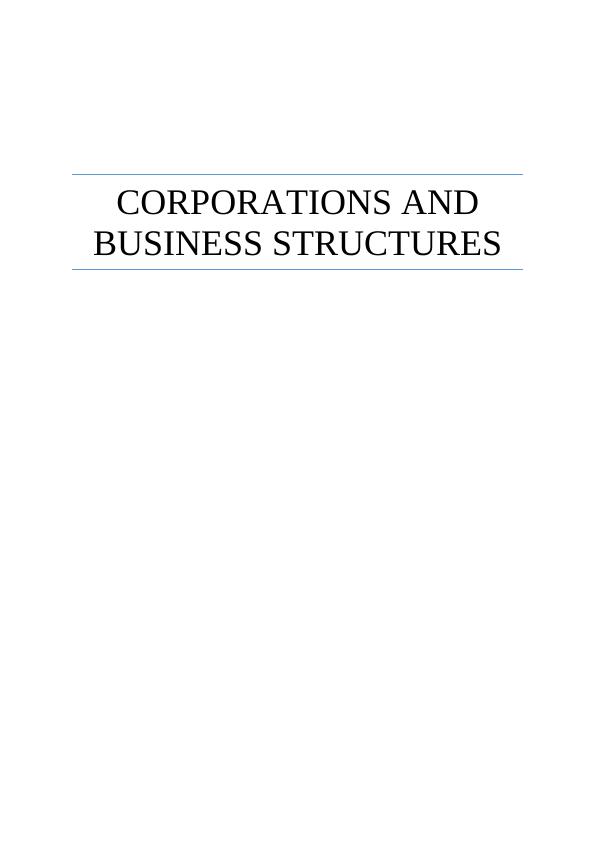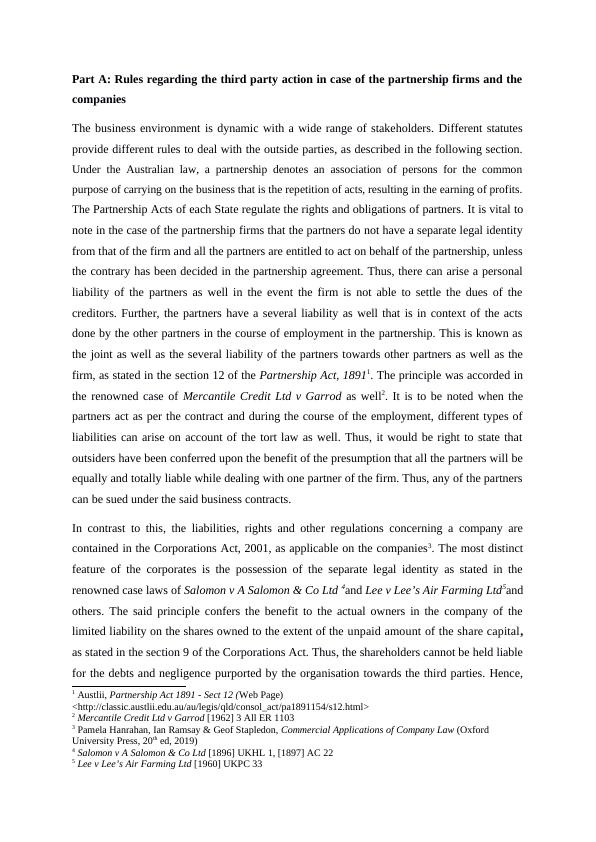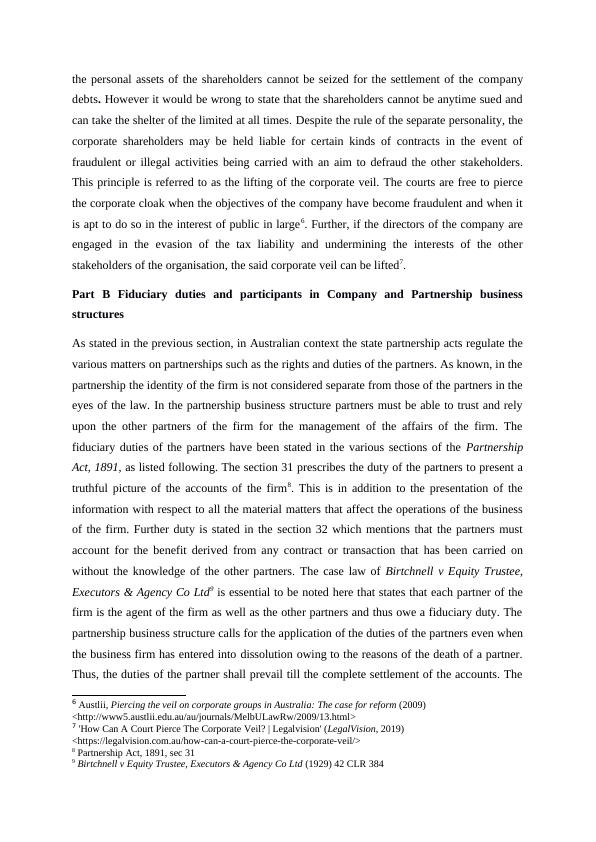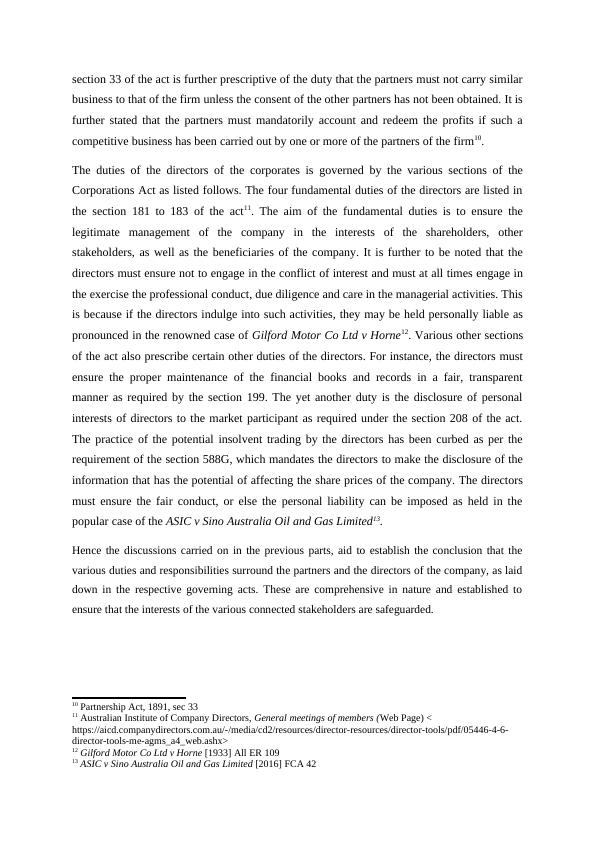Corporations and Business Structures: Rules, Duties, and Significance of ASIC v Vizard Case
Added on 2022-10-12
11 Pages3230 Words105 Views
CORPORATIONS AND
BUSINESS STRUCTURES
BUSINESS STRUCTURES

Part A: Rules regarding the third party action in case of the partnership firms and the
companies
The business environment is dynamic with a wide range of stakeholders. Different statutes
provide different rules to deal with the outside parties, as described in the following section.
Under the Australian law, a partnership denotes an association of persons for the common
purpose of carrying on the business that is the repetition of acts, resulting in the earning of profits.
The Partnership Acts of each State regulate the rights and obligations of partners. It is vital to
note in the case of the partnership firms that the partners do not have a separate legal identity
from that of the firm and all the partners are entitled to act on behalf of the partnership, unless
the contrary has been decided in the partnership agreement. Thus, there can arise a personal
liability of the partners as well in the event the firm is not able to settle the dues of the
creditors. Further, the partners have a several liability as well that is in context of the acts
done by the other partners in the course of employment in the partnership. This is known as
the joint as well as the several liability of the partners towards other partners as well as the
firm, as stated in the section 12 of the Partnership Act, 18911. The principle was accorded in
the renowned case of Mercantile Credit Ltd v Garrod as well2. It is to be noted when the
partners act as per the contract and during the course of the employment, different types of
liabilities can arise on account of the tort law as well. Thus, it would be right to state that
outsiders have been conferred upon the benefit of the presumption that all the partners will be
equally and totally liable while dealing with one partner of the firm. Thus, any of the partners
can be sued under the said business contracts.
In contrast to this, the liabilities, rights and other regulations concerning a company are
contained in the Corporations Act, 2001, as applicable on the companies3. The most distinct
feature of the corporates is the possession of the separate legal identity as stated in the
renowned case laws of Salomon v A Salomon & Co Ltd 4and Lee v Lee’s Air Farming Ltd5and
others. The said principle confers the benefit to the actual owners in the company of the
limited liability on the shares owned to the extent of the unpaid amount of the share capital,
as stated in the section 9 of the Corporations Act. Thus, the shareholders cannot be held liable
for the debts and negligence purported by the organisation towards the third parties. Hence,
1 Austlii, Partnership Act 1891 - Sect 12 (Web Page)
<http://classic.austlii.edu.au/au/legis/qld/consol_act/pa1891154/s12.html>
2 Mercantile Credit Ltd v Garrod [1962] 3 All ER 1103
3 Pamela Hanrahan, Ian Ramsay & Geof Stapledon, Commercial Applications of Company Law (Oxford
University Press, 20th ed, 2019)
4 Salomon v A Salomon & Co Ltd [1896] UKHL 1, [1897] AC 22
5 Lee v Lee’s Air Farming Ltd [1960] UKPC 33
companies
The business environment is dynamic with a wide range of stakeholders. Different statutes
provide different rules to deal with the outside parties, as described in the following section.
Under the Australian law, a partnership denotes an association of persons for the common
purpose of carrying on the business that is the repetition of acts, resulting in the earning of profits.
The Partnership Acts of each State regulate the rights and obligations of partners. It is vital to
note in the case of the partnership firms that the partners do not have a separate legal identity
from that of the firm and all the partners are entitled to act on behalf of the partnership, unless
the contrary has been decided in the partnership agreement. Thus, there can arise a personal
liability of the partners as well in the event the firm is not able to settle the dues of the
creditors. Further, the partners have a several liability as well that is in context of the acts
done by the other partners in the course of employment in the partnership. This is known as
the joint as well as the several liability of the partners towards other partners as well as the
firm, as stated in the section 12 of the Partnership Act, 18911. The principle was accorded in
the renowned case of Mercantile Credit Ltd v Garrod as well2. It is to be noted when the
partners act as per the contract and during the course of the employment, different types of
liabilities can arise on account of the tort law as well. Thus, it would be right to state that
outsiders have been conferred upon the benefit of the presumption that all the partners will be
equally and totally liable while dealing with one partner of the firm. Thus, any of the partners
can be sued under the said business contracts.
In contrast to this, the liabilities, rights and other regulations concerning a company are
contained in the Corporations Act, 2001, as applicable on the companies3. The most distinct
feature of the corporates is the possession of the separate legal identity as stated in the
renowned case laws of Salomon v A Salomon & Co Ltd 4and Lee v Lee’s Air Farming Ltd5and
others. The said principle confers the benefit to the actual owners in the company of the
limited liability on the shares owned to the extent of the unpaid amount of the share capital,
as stated in the section 9 of the Corporations Act. Thus, the shareholders cannot be held liable
for the debts and negligence purported by the organisation towards the third parties. Hence,
1 Austlii, Partnership Act 1891 - Sect 12 (Web Page)
<http://classic.austlii.edu.au/au/legis/qld/consol_act/pa1891154/s12.html>
2 Mercantile Credit Ltd v Garrod [1962] 3 All ER 1103
3 Pamela Hanrahan, Ian Ramsay & Geof Stapledon, Commercial Applications of Company Law (Oxford
University Press, 20th ed, 2019)
4 Salomon v A Salomon & Co Ltd [1896] UKHL 1, [1897] AC 22
5 Lee v Lee’s Air Farming Ltd [1960] UKPC 33

the personal assets of the shareholders cannot be seized for the settlement of the company
debts. However it would be wrong to state that the shareholders cannot be anytime sued and
can take the shelter of the limited at all times. Despite the rule of the separate personality, the
corporate shareholders may be held liable for certain kinds of contracts in the event of
fraudulent or illegal activities being carried with an aim to defraud the other stakeholders.
This principle is referred to as the lifting of the corporate veil. The courts are free to pierce
the corporate cloak when the objectives of the company have become fraudulent and when it
is apt to do so in the interest of public in large6. Further, if the directors of the company are
engaged in the evasion of the tax liability and undermining the interests of the other
stakeholders of the organisation, the said corporate veil can be lifted7.
Part B Fiduciary duties and participants in Company and Partnership business
structures
As stated in the previous section, in Australian context the state partnership acts regulate the
various matters on partnerships such as the rights and duties of the partners. As known, in the
partnership the identity of the firm is not considered separate from those of the partners in the
eyes of the law. In the partnership business structure partners must be able to trust and rely
upon the other partners of the firm for the management of the affairs of the firm. The
fiduciary duties of the partners have been stated in the various sections of the Partnership
Act, 1891, as listed following. The section 31 prescribes the duty of the partners to present a
truthful picture of the accounts of the firm8. This is in addition to the presentation of the
information with respect to all the material matters that affect the operations of the business
of the firm. Further duty is stated in the section 32 which mentions that the partners must
account for the benefit derived from any contract or transaction that has been carried on
without the knowledge of the other partners. The case law of Birtchnell v Equity Trustee,
Executors & Agency Co Ltd9 is essential to be noted here that states that each partner of the
firm is the agent of the firm as well as the other partners and thus owe a fiduciary duty. The
partnership business structure calls for the application of the duties of the partners even when
the business firm has entered into dissolution owing to the reasons of the death of a partner.
Thus, the duties of the partner shall prevail till the complete settlement of the accounts. The
6 Austlii, Piercing the veil on corporate groups in Australia: The case for reform (2009)
<http://www5.austlii.edu.au/au/journals/MelbULawRw/2009/13.html>
7 'How Can A Court Pierce The Corporate Veil? | Legalvision' (LegalVision, 2019)
<https://legalvision.com.au/how-can-a-court-pierce-the-corporate-veil/>
8 Partnership Act, 1891, sec 31
9 Birtchnell v Equity Trustee, Executors & Agency Co Ltd (1929) 42 CLR 384
debts. However it would be wrong to state that the shareholders cannot be anytime sued and
can take the shelter of the limited at all times. Despite the rule of the separate personality, the
corporate shareholders may be held liable for certain kinds of contracts in the event of
fraudulent or illegal activities being carried with an aim to defraud the other stakeholders.
This principle is referred to as the lifting of the corporate veil. The courts are free to pierce
the corporate cloak when the objectives of the company have become fraudulent and when it
is apt to do so in the interest of public in large6. Further, if the directors of the company are
engaged in the evasion of the tax liability and undermining the interests of the other
stakeholders of the organisation, the said corporate veil can be lifted7.
Part B Fiduciary duties and participants in Company and Partnership business
structures
As stated in the previous section, in Australian context the state partnership acts regulate the
various matters on partnerships such as the rights and duties of the partners. As known, in the
partnership the identity of the firm is not considered separate from those of the partners in the
eyes of the law. In the partnership business structure partners must be able to trust and rely
upon the other partners of the firm for the management of the affairs of the firm. The
fiduciary duties of the partners have been stated in the various sections of the Partnership
Act, 1891, as listed following. The section 31 prescribes the duty of the partners to present a
truthful picture of the accounts of the firm8. This is in addition to the presentation of the
information with respect to all the material matters that affect the operations of the business
of the firm. Further duty is stated in the section 32 which mentions that the partners must
account for the benefit derived from any contract or transaction that has been carried on
without the knowledge of the other partners. The case law of Birtchnell v Equity Trustee,
Executors & Agency Co Ltd9 is essential to be noted here that states that each partner of the
firm is the agent of the firm as well as the other partners and thus owe a fiduciary duty. The
partnership business structure calls for the application of the duties of the partners even when
the business firm has entered into dissolution owing to the reasons of the death of a partner.
Thus, the duties of the partner shall prevail till the complete settlement of the accounts. The
6 Austlii, Piercing the veil on corporate groups in Australia: The case for reform (2009)
<http://www5.austlii.edu.au/au/journals/MelbULawRw/2009/13.html>
7 'How Can A Court Pierce The Corporate Veil? | Legalvision' (LegalVision, 2019)
<https://legalvision.com.au/how-can-a-court-pierce-the-corporate-veil/>
8 Partnership Act, 1891, sec 31
9 Birtchnell v Equity Trustee, Executors & Agency Co Ltd (1929) 42 CLR 384

section 33 of the act is further prescriptive of the duty that the partners must not carry similar
business to that of the firm unless the consent of the other partners has not been obtained. It is
further stated that the partners must mandatorily account and redeem the profits if such a
competitive business has been carried out by one or more of the partners of the firm10.
The duties of the directors of the corporates is governed by the various sections of the
Corporations Act as listed follows. The four fundamental duties of the directors are listed in
the section 181 to 183 of the act11. The aim of the fundamental duties is to ensure the
legitimate management of the company in the interests of the shareholders, other
stakeholders, as well as the beneficiaries of the company. It is further to be noted that the
directors must ensure not to engage in the conflict of interest and must at all times engage in
the exercise the professional conduct, due diligence and care in the managerial activities. This
is because if the directors indulge into such activities, they may be held personally liable as
pronounced in the renowned case of Gilford Motor Co Ltd v Horne12. Various other sections
of the act also prescribe certain other duties of the directors. For instance, the directors must
ensure the proper maintenance of the financial books and records in a fair, transparent
manner as required by the section 199. The yet another duty is the disclosure of personal
interests of directors to the market participant as required under the section 208 of the act.
The practice of the potential insolvent trading by the directors has been curbed as per the
requirement of the section 588G, which mandates the directors to make the disclosure of the
information that has the potential of affecting the share prices of the company. The directors
must ensure the fair conduct, or else the personal liability can be imposed as held in the
popular case of the ASIC v Sino Australia Oil and Gas Limited13.
Hence the discussions carried on in the previous parts, aid to establish the conclusion that the
various duties and responsibilities surround the partners and the directors of the company, as laid
down in the respective governing acts. These are comprehensive in nature and established to
ensure that the interests of the various connected stakeholders are safeguarded.
10 Partnership Act, 1891, sec 33
11 Australian Institute of Company Directors, General meetings of members (Web Page) <
https://aicd.companydirectors.com.au/-/media/cd2/resources/director-resources/director-tools/pdf/05446-4-6-
director-tools-me-agms_a4_web.ashx>
12 Gilford Motor Co Ltd v Horne [1933] All ER 109
13 ASIC v Sino Australia Oil and Gas Limited [2016] FCA 42
business to that of the firm unless the consent of the other partners has not been obtained. It is
further stated that the partners must mandatorily account and redeem the profits if such a
competitive business has been carried out by one or more of the partners of the firm10.
The duties of the directors of the corporates is governed by the various sections of the
Corporations Act as listed follows. The four fundamental duties of the directors are listed in
the section 181 to 183 of the act11. The aim of the fundamental duties is to ensure the
legitimate management of the company in the interests of the shareholders, other
stakeholders, as well as the beneficiaries of the company. It is further to be noted that the
directors must ensure not to engage in the conflict of interest and must at all times engage in
the exercise the professional conduct, due diligence and care in the managerial activities. This
is because if the directors indulge into such activities, they may be held personally liable as
pronounced in the renowned case of Gilford Motor Co Ltd v Horne12. Various other sections
of the act also prescribe certain other duties of the directors. For instance, the directors must
ensure the proper maintenance of the financial books and records in a fair, transparent
manner as required by the section 199. The yet another duty is the disclosure of personal
interests of directors to the market participant as required under the section 208 of the act.
The practice of the potential insolvent trading by the directors has been curbed as per the
requirement of the section 588G, which mandates the directors to make the disclosure of the
information that has the potential of affecting the share prices of the company. The directors
must ensure the fair conduct, or else the personal liability can be imposed as held in the
popular case of the ASIC v Sino Australia Oil and Gas Limited13.
Hence the discussions carried on in the previous parts, aid to establish the conclusion that the
various duties and responsibilities surround the partners and the directors of the company, as laid
down in the respective governing acts. These are comprehensive in nature and established to
ensure that the interests of the various connected stakeholders are safeguarded.
10 Partnership Act, 1891, sec 33
11 Australian Institute of Company Directors, General meetings of members (Web Page) <
https://aicd.companydirectors.com.au/-/media/cd2/resources/director-resources/director-tools/pdf/05446-4-6-
director-tools-me-agms_a4_web.ashx>
12 Gilford Motor Co Ltd v Horne [1933] All ER 109
13 ASIC v Sino Australia Oil and Gas Limited [2016] FCA 42

End of preview
Want to access all the pages? Upload your documents or become a member.
Related Documents
Partnership Law Assignment 2022lg...
|9
|2344
|18
Liability of a Holding Company for the Negligence of its Subsidiarylg...
|9
|2477
|184
Duties of Directors in Company and Partnership Structureslg...
|9
|2711
|1
Corporate Veil and Limited Liability in International Business Lawlg...
|13
|4988
|284
Liability of David for Trade Clause Violation and Failure to Pay Instalmentlg...
|7
|2196
|37
Corporation Lawlg...
|8
|1847
|436
